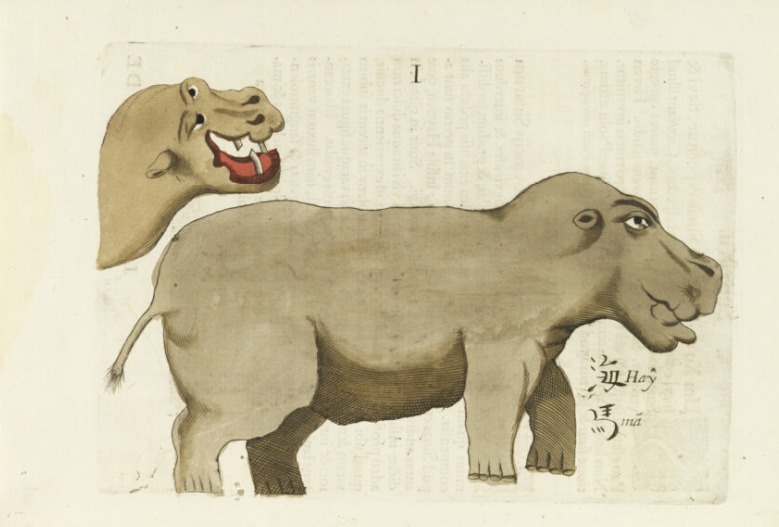Polish description of China – conference
From 19-20 April 2023, the Ossolinum Refectory will host a conference combined with a Chinese-Latin workshop. ‘In the footsteps of Michał Boym, Tomasz Dunin-Szpot and Edward Kajdański. A Polish Description of China’
Staff from the Ossolineum will also be present to provide the audience with a picture of ancient China from the perspective of the collections of the Ossolineum Library.
The description of China in Poland began with the Jesuits. Michael Boym was an ambassador of the Ming dynasty in Europe and a sinologist who authored many works on China. He was part of the first generation of European sinologists. Edward Kajdański was a historian who was discovering Polish pages in Chinese history like no one else. He researched into the work of Michael Boym and popularized his figure in the historical consciousness of Poles. We mention another Jesuit among the spiritual patrons of our conference – Thomas Dunin-Szpot. He authored numerous works on China from the Qing dynasty that remain in manuscripts, covering more than 2,500 pages. One of his works is Historia imperii Sinarum, and its critical edition is currently being prepared for publication by a group under the direction of prof. Janusza Smołucha. The conference will be accompanied by a Chinese-Latin workshop where students and anyone interested will be able to learn about the specific nature of European manuscripts, old prints, maps and atlases from the 16th to 18th centuries describing China in the Ossolineum.
The conference is organised by: the Institute of Classical, Mediterranean and Oriental Studies of the University of Wrocław, the Ossoliński National Institute; Jesuit University Ignatianum in Krakow; Asian Studies Centre]
The conference programme:
‘In the footsteps of Michał Boym, Tomasz Dunin-Szpot and Edward Kajdański. A Polish Description of China’ 19-20 April, 2023
Wednesday – 19 April 2023
9.30-10.00 AM Piotr Galik (The Ossoliński National Institute) – Kartograficzny obraz Chin w zbiorach Biblioteki Ossolineum [Cartographic image of China in the Ossolineum collection]
10.00–10.30 AM Monika Miazek-Męczyńska (Adam Mickiewicz University, Poznań) – Misja Michała Boyma udokumentowana w pismach Tomasza Dunina-Szpota [The mission of Michael Boym as documented in the writings of Thomas Dunin-Szpot]
10.30-11.00 AM Hanna Wadas (Jesuit University Ignatianum in Krakow) – Odkrycie i znaczenie steli z Xian dla misji jezuickich w Chinach w XVII wieku w świetle relacji Tomasza Szpota Dunina (1644-1713) [The discovery and significance of the Xian stele for the Jesuit missions in China in the 17th century in accordance with the account of Tomasz Szpot Dunin (1644-1713)]
11.00-11.30 AM Krzysztof Bekieszczuk (University of Wrocław) – Pierwsze wygnanie jezuitów z Chin (1617) w narracji Tomasza Dunina Szpota [The first exile of the Jesuits from China (1617) as narrated by Thomas Dunin Szpot]
11.30 AM-12.00 PM Bartłomiej Wołyniec (The Pontifical University of John Paul II in Krakow) – Rola i znaczenie kolegiów jezuickich w propagowaniu wśród mieszkańców Rzeczypospolitej wiedzy na temat działalności misyjnej Towarzystwa Jezusowego na Dalekim Wschodzie [The role and importance of the Jesuit colleges in promoting knowledge among the Polish people about the missionary activities of the Society of Jesus in the Far East]
12.00-12.30 PM – coffee break
12.30-1.00 PM Janusz Smołucha (Jesuit University Ignatianum in Krakow) – Okoliczności śmierci i pogrzebu Matteo Ricciego SJ w relacji Tomasza Szpota Dunina [Circumstances of the death and funeral of Matteo Ricci SJ in the account of Tomasz Szpot Dunin]
1.00-1.30 PM Andrzej Wadas (Jesuit University Ignatianum in Krakow) – Gravissima pericula. Kryzys 1606 roku w Macau w opisie Tomasza Szpota Dunina [Gravissima pericula. The crisis of 1606 in Macau in the description of Tomasz Szpot Dunin]
1.30-2.00 PM Łukasz Burkiewicz (Jesuit University Ignatianum in Krakow) – Polityczna, gospodarcza i kulturowa rola chińskiego Wielkiego Kanału w kontekście opisu Tomasza Dunina Szpota [The political, economic and cultural role of China’s Grand Canal in the context of Tomasz Dunin Szpot’s description]
2.00-3.00 PM Konrad Szymański (The Ossoliński National Institute) – prezentacja wybranych starodruków na temat Chin ze zbiorów Działu Starych Druków Biblioteki Ossolineum [presentation of selected old prints regarding China from the collection of the Department of Old Prints of the Ossolineum]
3.00-4.00 PM workshop Z prac nad wydaniem drukiem Historia imperii Sinarum Tomasz Dunina Szpota SJ po 310 latach od planowanego terminu – Gościwit Malinowski
[From the works on the print publication Historia imperii Sinarum by Tomasz Dunin Szpot SJ after 310 years – Gościwit Malinowski]
Thursday, 20 April 2023
11.00-11.30 AM Bogdan Zemanek (Jagiellonian University in Kraków) – (Nie)specjaliści i (a)historycy o Chinach – Lewicka i spółka [(Non) specialists and (non) historians on China – Lewicka and associates]
11.30 AM-12.00 PM Maria Anna Dudek (Jagiellonian University in Kraków) – Obraz Chin i Japonii w literaturze młodzieżowej Anny Lewickiej na przykładzie zbioru „Wśród dzieci i młodzieży różnych krajów” [The image of China and Japan in Anna Lewicka’s youth literature on the example of the collection ‘Wśród dzieci i młodzieży różnych krajów’]
12.00-12.30 PM Marceli Burdelski (University of Gdańsk) – Edward Kajdański – życie i dzieło [Edward Kajdański – life and work]
12.30-1.00 PM Gościwit Malinowski (University of Wrocław) – Bronowice AD 1900 – polska wieś zaciszna czy globalna wioska? [Bronowice AD 1900 – Polish secluded village or global village?]
Translated by Klaudia Kuśnierz (student of English Studies at the University of Wrocław) as part of the translation practice.




